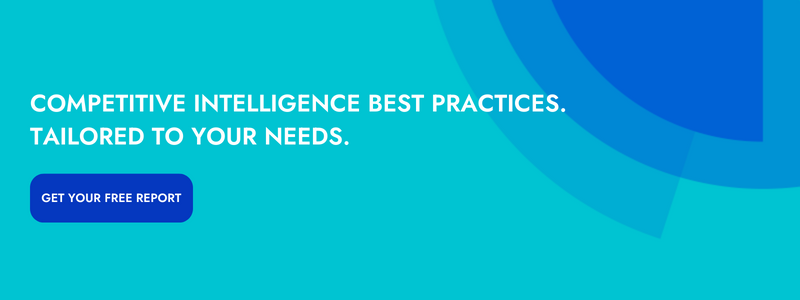In the B2B world, you can’t go to market with a product that’s identical to that of your competitor. Without some form of differentiation, your chances of succeeding over the long term are slim.
Fortunately, each of your competitors has to play by the same rules. If one of them were to go to market with a product identical to yours, they probably wouldn’t stick around for very long.
With the need to differentiate comes the need to make trade-offs. If your plan to differentiate involves a heavy investment in Feature X, it’s inevitable that — for the time being — Feature Y is going to be lacking.
Right now, your competitors are making trade-offs — which means they have weaknesses that you can use to your advantage.
Today, we’ll discuss three ways to find your competitors’ weaknesses and three ways to use those weaknesses to your advantage.
Let’s jump in!
NEED COMPETITIVE INTELLIGENCE BEST PRACTICES? USE OUR FREE TOOL >>
3 Ways to Find Your Competitors’ Weaknesses
Although this is not an exhaustive list of sources of competitive intelligence, the following three tactics should give you a strong sense of where your competitors are coming up short.
1. Talk to Your Sales Reps & Customers
Field intelligence is exactly what it sounds like: competitive intel that comes from folks who are out in the field — i.e., your sales reps and your customers.
Day in and day out, your sales reps talk to prospects who are simultaneously evaluating your solution and the solutions offered by your competitors. Naturally, over the course of hundreds of conversations, your reps will get an idea of what each competitor does well and what each competitor does poorly. To ensure that you’re always getting value out of these insights, make it a habit to chat with your reps about your competitors’ weaknesses.
Your customer base is a wealth of information, too. Many of your customers have evaluated your competitors’ solutions, and some of them have actually used their solutions. What better way to find your competitors’ weaknesses than to speak with customers who made the switch?
2. Scrutinize Online Reviews
Unfortunately, just because someone is unhappy with one of your competitors, doesn’t mean they’re automatically going to give you their business. In other words, you can’t rely solely on your customers' insights to find your competitors’ weaknesses.
Online reviews can go a long way towards filling in the gaps. Once you’ve found the website(s) that buyers in your market are using to share product reviews with their peers, conduct an analysis for each of your competitors. As you scrutinize the reviews — good and bad — make note of any patterns you observe. What’s going unmentioned across the good reviews? What’s getting lambasted across the bad reviews?
Generally, you can expect to see a fair amount of overlap between the insights you get from sales reps and customers and the insights you get from online reviews.
3. Track Personnel Changes
Talking to sales reps, talking to customers, scrutinizing online reviews — although these are fantastic ways to find your competitors’ weaknesses, they’re fairly obvious suggestions.
So, for our third and final tactic, let’s dig a little deeper.
You can learn a lot about a competitor — including their weaknesses — by tracking changes in their personnel. As I said earlier, with the need to differentiate comes the need to make trade-offs. Well, as you take stock of the people your competitor is hiring, can you make an educated guess as to where they’re focusing their resources? More importantly, can you make an educated guess as to where they’re not focusing their resources?
You may also want to take note of the people who leave your competitor’s organization. Can you discern any kind of pattern? If there appears to an exodus from one particular department within your competitor’s organization, that’s probably worth a closer look.
(Remember: Expect to see overlap!)
3 Ways to Leverage Your Competitors’ Weaknesses
Knowing your competitors’ weaknesses is only half the battle. Let’s wrap up with three action items to help you use this newfound knowledge to your advantage.
1. Tweak Your Messaging (Not Too Much)
[Important note: Don’t obsess over your competitors. Your messaging, at its core, should be about your customers and the pain points they’re seeking to alleviate. Competitive intel should inform your messaging, but it should never dominate your messaging.]
Once you’ve nailed down your competitors’ weaknesses, you may see an opportunity to tweak your messaging accordingly. For example, let’s say you’ve discovered that several of your competitors are failing to sufficiently address one pain point in particular; by comparison, your product addresses it quite effectively. In this case, it may be worthwhile to update your messaging in order to place a greater emphasis on the pain point in question.
To flesh out this example, let’s say you’re a marketer at a company that sells chronic condition management software to enterprise employers. In the process of finding your competitors’ weaknesses, you’ve discovered that your product does the best job of addressing a key pain point: enabling employers to drive adoption of the software throughout their organizations.
If I were you, I would look at the messaging on your website and see if there are any opportunities to place a greater emphasis on employee onboarding.
2. Optimize Your Battlecards
Because battlecards are designed to help your sales reps talk about competitors in an effective manner, your competitors’ weaknesses should be featured prominently. (In order to help your reps handle prospects’ objections to the best of their ability, your strengths should also be featured prominently, in addition to specific tactics for handling the objections.)
Drawing on our previous example, let’s say one of your reps is speaking with a prospect who’s evaluating a number of chronic condition management solutions. Halfway through the call, the prospect mentions the importance of employee onboarding and company-wide adoption. Because you’ve optimized your battlecards, your rep is well-prepared to address the prospect’s comment and leverage your competitors’ weaknesses.
3. Keep Customer Success in the Loop
It’s important to win new business — and it’s equally important to retain the business you’ve already won. When you find your competitors’ weaknesses, make sure to keep your customer success team in the loop. These reps can use your insights to their advantage when they’re speaking with at-risk customers who are considering a switch to one of your competitors.
For whatever reason, say one of your customers is a little unhappy with your chronic condition management software, and they’re thinking about taking a look at other solutions in the market. Although saving this relationship will require more than a couple bullet points on your competitors’ weaknesses, your customer success reps should always have them at the ready.
Use Your Competitors’ Weaknesses to Your Advantage
Your market is only going to get more competitive as time goes on. The sooner you can adopt a competitive mindset, the better off you’ll be.
Although there’s a lot more to competitive intelligence than simply finding your competitors’ weaknesses, the tactics we’ve outlined today will help you get started. If you can make it a habit to talk to sales reps, talk to customers, scrutinize online reviews, track personnel changes, and leverage your insights effectively, you’ll be in great shape to win and retain more customers.




